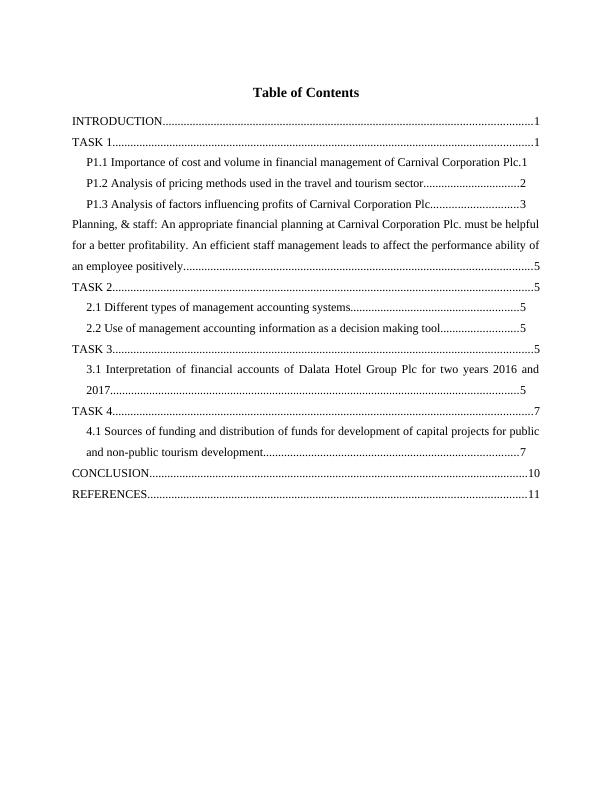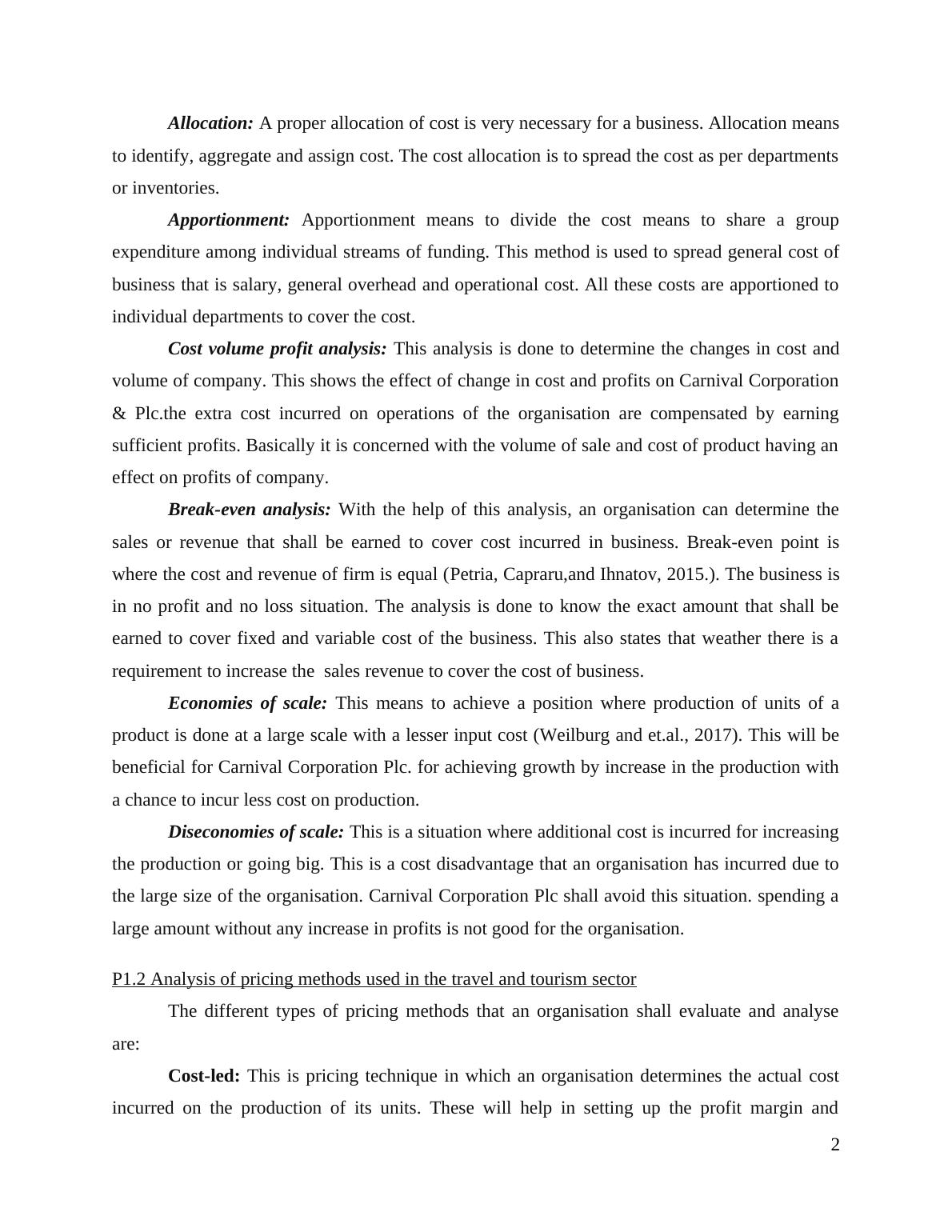Finance and Funding in the Travel and Tourism Sector
Added on 2023-02-03
15 Pages3760 Words99 Views
Finance and Funding in the Travel and Tourism
Sector
Sector

Table of Contents
INTRODUCTION...........................................................................................................................1
TASK 1............................................................................................................................................1
P1.1 Importance of cost and volume in financial management of Carnival Corporation Plc.1
P1.2 Analysis of pricing methods used in the travel and tourism sector................................2
P1.3 Analysis of factors influencing profits of Carnival Corporation Plc.............................3
Planning, & staff: An appropriate financial planning at Carnival Corporation Plc. must be helpful
for a better profitability. An efficient staff management leads to affect the performance ability of
an employee positively....................................................................................................................5
TASK 2............................................................................................................................................5
2.1 Different types of management accounting systems........................................................5
2.2 Use of management accounting information as a decision making tool..........................5
TASK 3............................................................................................................................................5
3.1 Interpretation of financial accounts of Dalata Hotel Group Plc for two years 2016 and
2017........................................................................................................................................5
TASK 4............................................................................................................................................7
4.1 Sources of funding and distribution of funds for development of capital projects for public
and non-public tourism development.....................................................................................7
CONCLUSION..............................................................................................................................10
REFERENCES..............................................................................................................................11
INTRODUCTION...........................................................................................................................1
TASK 1............................................................................................................................................1
P1.1 Importance of cost and volume in financial management of Carnival Corporation Plc.1
P1.2 Analysis of pricing methods used in the travel and tourism sector................................2
P1.3 Analysis of factors influencing profits of Carnival Corporation Plc.............................3
Planning, & staff: An appropriate financial planning at Carnival Corporation Plc. must be helpful
for a better profitability. An efficient staff management leads to affect the performance ability of
an employee positively....................................................................................................................5
TASK 2............................................................................................................................................5
2.1 Different types of management accounting systems........................................................5
2.2 Use of management accounting information as a decision making tool..........................5
TASK 3............................................................................................................................................5
3.1 Interpretation of financial accounts of Dalata Hotel Group Plc for two years 2016 and
2017........................................................................................................................................5
TASK 4............................................................................................................................................7
4.1 Sources of funding and distribution of funds for development of capital projects for public
and non-public tourism development.....................................................................................7
CONCLUSION..............................................................................................................................10
REFERENCES..............................................................................................................................11

INTRODUCTION
For an organisation in travel and tourism sector, it is important to manage the finance and
funding. For any business, the most important part for running a business is finance, so it is very
important to know from where the funds will generate and how the financial resources will be
managed. In this report, an evaluation of funding and finance in respect of travel and tourism
sector is done for Carnival Corporation & Plc. For this, an analysis of cost volume and profits are
done along with the evaluation of pricing strategies. All the factors related to profit are also
analysed. An analysis regarding Dalata hotel Group plc is done here. This is done considering
the financial accounts of hotel and distribution of funds for development of tourism.
TASK 1
P1.1 Importance of cost and volume in financial management of Carnival Corporation Plc.
Cost means the amount paid to the staff or employees of the organisation for providing
travel services to people. Cost is incurred for the use of goods and services so that output
services can be provided. Different types of costs incurred are:
Direct costs: The direct cost includes direct materials, direct labour, piece rate wages,
commission and manufacturing supplies (Khidmat and Rehman, 2014). In travel industry, the
direct cost is wages to staff and material consumed for providing the services. The commission
paid to the agents and hotels are a pary off direct cost.
Indirect costs: This is the cost which is incurred for operations of business activities.
This cost is necessary for running the business. The cost includes overhead expenses such as rent
and utilities, administrative expenses such as office salary, cost of accounting and personnel
department.
Fixed costs: This cost is the one which has to be incurred essentially. This is incurred
irrespective of the volume of production or sales. In the travel and tourism sector, the fixed cost
can be in respect of rent of the premises, salaries and wage, as this cost has to be paid
irrespective with increase or decrease in number of people. Travelling.
Variable cost: The variable cost differs with change in output be it sales or production.
An increase in sales will raise variable cost and a decrease in sale will lower variable cost. The
variable cost can be salaries to drivers and rents of vehicles.
1
For an organisation in travel and tourism sector, it is important to manage the finance and
funding. For any business, the most important part for running a business is finance, so it is very
important to know from where the funds will generate and how the financial resources will be
managed. In this report, an evaluation of funding and finance in respect of travel and tourism
sector is done for Carnival Corporation & Plc. For this, an analysis of cost volume and profits are
done along with the evaluation of pricing strategies. All the factors related to profit are also
analysed. An analysis regarding Dalata hotel Group plc is done here. This is done considering
the financial accounts of hotel and distribution of funds for development of tourism.
TASK 1
P1.1 Importance of cost and volume in financial management of Carnival Corporation Plc.
Cost means the amount paid to the staff or employees of the organisation for providing
travel services to people. Cost is incurred for the use of goods and services so that output
services can be provided. Different types of costs incurred are:
Direct costs: The direct cost includes direct materials, direct labour, piece rate wages,
commission and manufacturing supplies (Khidmat and Rehman, 2014). In travel industry, the
direct cost is wages to staff and material consumed for providing the services. The commission
paid to the agents and hotels are a pary off direct cost.
Indirect costs: This is the cost which is incurred for operations of business activities.
This cost is necessary for running the business. The cost includes overhead expenses such as rent
and utilities, administrative expenses such as office salary, cost of accounting and personnel
department.
Fixed costs: This cost is the one which has to be incurred essentially. This is incurred
irrespective of the volume of production or sales. In the travel and tourism sector, the fixed cost
can be in respect of rent of the premises, salaries and wage, as this cost has to be paid
irrespective with increase or decrease in number of people. Travelling.
Variable cost: The variable cost differs with change in output be it sales or production.
An increase in sales will raise variable cost and a decrease in sale will lower variable cost. The
variable cost can be salaries to drivers and rents of vehicles.
1

Allocation: A proper allocation of cost is very necessary for a business. Allocation means
to identify, aggregate and assign cost. The cost allocation is to spread the cost as per departments
or inventories.
Apportionment: Apportionment means to divide the cost means to share a group
expenditure among individual streams of funding. This method is used to spread general cost of
business that is salary, general overhead and operational cost. All these costs are apportioned to
individual departments to cover the cost.
Cost volume profit analysis: This analysis is done to determine the changes in cost and
volume of company. This shows the effect of change in cost and profits on Carnival Corporation
& Plc.the extra cost incurred on operations of the organisation are compensated by earning
sufficient profits. Basically it is concerned with the volume of sale and cost of product having an
effect on profits of company.
Break-even analysis: With the help of this analysis, an organisation can determine the
sales or revenue that shall be earned to cover cost incurred in business. Break-even point is
where the cost and revenue of firm is equal (Petria, Capraru,and Ihnatov, 2015.). The business is
in no profit and no loss situation. The analysis is done to know the exact amount that shall be
earned to cover fixed and variable cost of the business. This also states that weather there is a
requirement to increase the sales revenue to cover the cost of business.
Economies of scale: This means to achieve a position where production of units of a
product is done at a large scale with a lesser input cost (Weilburg and et.al., 2017). This will be
beneficial for Carnival Corporation Plc. for achieving growth by increase in the production with
a chance to incur less cost on production.
Diseconomies of scale: This is a situation where additional cost is incurred for increasing
the production or going big. This is a cost disadvantage that an organisation has incurred due to
the large size of the organisation. Carnival Corporation Plc shall avoid this situation. spending a
large amount without any increase in profits is not good for the organisation.
P1.2 Analysis of pricing methods used in the travel and tourism sector
The different types of pricing methods that an organisation shall evaluate and analyse
are:
Cost-led: This is pricing technique in which an organisation determines the actual cost
incurred on the production of its units. These will help in setting up the profit margin and
2
to identify, aggregate and assign cost. The cost allocation is to spread the cost as per departments
or inventories.
Apportionment: Apportionment means to divide the cost means to share a group
expenditure among individual streams of funding. This method is used to spread general cost of
business that is salary, general overhead and operational cost. All these costs are apportioned to
individual departments to cover the cost.
Cost volume profit analysis: This analysis is done to determine the changes in cost and
volume of company. This shows the effect of change in cost and profits on Carnival Corporation
& Plc.the extra cost incurred on operations of the organisation are compensated by earning
sufficient profits. Basically it is concerned with the volume of sale and cost of product having an
effect on profits of company.
Break-even analysis: With the help of this analysis, an organisation can determine the
sales or revenue that shall be earned to cover cost incurred in business. Break-even point is
where the cost and revenue of firm is equal (Petria, Capraru,and Ihnatov, 2015.). The business is
in no profit and no loss situation. The analysis is done to know the exact amount that shall be
earned to cover fixed and variable cost of the business. This also states that weather there is a
requirement to increase the sales revenue to cover the cost of business.
Economies of scale: This means to achieve a position where production of units of a
product is done at a large scale with a lesser input cost (Weilburg and et.al., 2017). This will be
beneficial for Carnival Corporation Plc. for achieving growth by increase in the production with
a chance to incur less cost on production.
Diseconomies of scale: This is a situation where additional cost is incurred for increasing
the production or going big. This is a cost disadvantage that an organisation has incurred due to
the large size of the organisation. Carnival Corporation Plc shall avoid this situation. spending a
large amount without any increase in profits is not good for the organisation.
P1.2 Analysis of pricing methods used in the travel and tourism sector
The different types of pricing methods that an organisation shall evaluate and analyse
are:
Cost-led: This is pricing technique in which an organisation determines the actual cost
incurred on the production of its units. These will help in setting up the profit margin and
2

End of preview
Want to access all the pages? Upload your documents or become a member.
Related Documents
Finance and Funding in the Travel and Tourism Assignment - Carnival Corporation & Plclg...
|17
|5364
|294
Finance and Funding in the Travel and Tourism Sectorlg...
|30
|3975
|193
Report on Finance & Funding in Travel & Tourism Sectorlg...
|22
|3025
|57
Finance and Funding in Travel and Tourism Sectorlg...
|30
|4791
|143
Finance and Funding in Travel and Tourism Sectorlg...
|30
|4198
|204
Finance and Funding in the Travel and Tourism Sectorlg...
|20
|5077
|84
